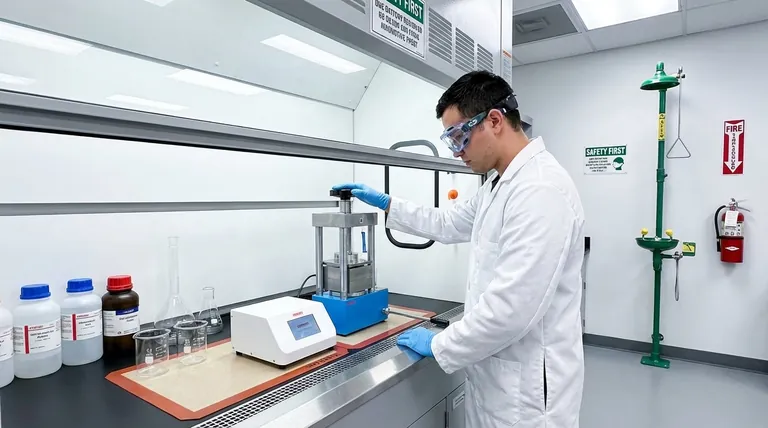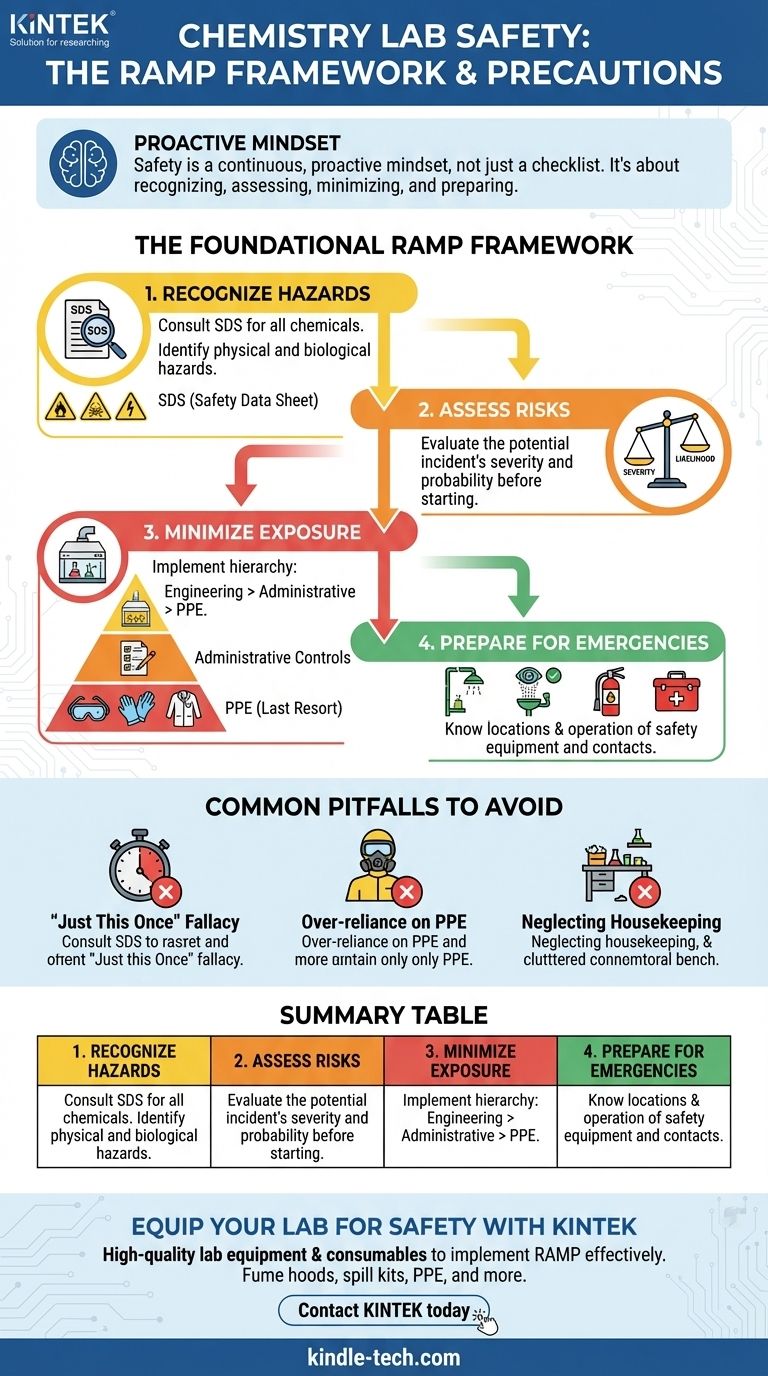化学实验室中最关键的预防措施围绕着对所涉及的材料和过程的根本尊重。至少,这包括始终佩戴适当的个人防护装备 (PPE),在处理每种化学品之前了解其具体危害,以及了解所有应急安全设备的确切位置和操作。切勿单独工作,并始终保持工作区域清洁有序,以防止事故发生。
真正的实验室安全不是一份需要记忆的规则清单,而是一种持续的、积极主动的心态。它建立在识别危害、评估风险、最小化暴露和在实验开始前做好应急准备的框架之上。
基本框架:RAMP
强大的安全文化建立在 RAMP 原则之上,这是一个简单而强大的框架,用于处理实验室中的每项任务。
识别危害
在任何工作开始之前,您必须识别潜在的危害源。危害并非总是显而易见的。
每种化学品都有相关的 安全数据表 (SDS),以前称为 MSDS。此文档是您了解可燃性、毒性、反应性和所需安全措施的主要信息来源。
除了化学品,还要考虑物理危害,如高压系统、极端温度和电气设备。如果适用,生物危害也需要其自身的特定协议。
评估风险
识别危害是第一步;评估其风险是下一步。风险是潜在事件的 严重性 和其发生的 可能性 的组合。
问问自己:最坏的情况是什么?这个实验可能如何失败?少量温和刺激物与大量高腐蚀性或爆炸性物质所造成的风险截然不同。
此评估决定了您需要为该程序实施的控制措施级别。
最小化危害
这是安全的主动部分——实施控制以降低风险。这按明确的层级进行。
最有效的方法是使用 工程控制,即消除危害的物理装置。最重要的例子是 通风橱,它将有毒或挥发性蒸汽从使用者身边排出。
接下来是 管理控制,即您遵循的程序和协议。这包括所有容器的正确标签、从不单独工作以及为您的实验制定标准操作程序 (SOP)。
最后一道防线是 个人防护装备 (PPE)。这包括防溅化学护目镜、阻燃实验服、适当的耐化学手套和包头鞋。PPE 并不能防止事故发生,但如果事故发生,它可以保护您免受伤害。
准备应急
即使有最好的计划,事故也可能发生。准备是必不可少的。
您必须知道 安全淋浴器、洗眼站、灭火器 和 溢出物处理包 的确切位置和正确操作方法。在紧急情况下,时间至关重要,没有时间寻找说明。
确保紧急联系电话清晰张贴,并且您了解实验室报告事故的具体程序,无论它们看起来多么微小。

常见陷阱和误解
对安全协议的遵守可能会因自满和对真正危险所在之处的误解而受到损害。避免这些常见陷阱与遵守规则本身一样重要。
“就这一次”的谬误
绝大多数实验室事故并非由异乎寻常的高风险程序引起。它们是由日常任务中的微小偏差引起的——“快速”转移时跳过护目镜,或“少量”化学品时不使用通风橱。
这种偏差的常态化是对安全实验室文化的最大威胁。没有哪项任务快到可以跳过基本安全措施。
过度依赖个人防护装备 (PPE)
许多人将个人防护装备视为安全的主要工具。这是不正确的。个人防护装备是 最后 的防线,旨在当所有其他控制措施都失效时保护您。
依靠手套来保护您免受飞溅远不如实施一个能从一开始就防止飞溅发生的程序有效。始终优先考虑工程和管理控制,而不是个人防护装备。
忽视良好的内务管理
凌乱的实验台、未贴标签的容器和堵塞的紧急出口会造成不必要且完全可以避免的危害。一个清洁有序的实验室直接反映了专业和有安全意识的心态。
良好的内务管理并非为了整洁本身;它是一项关键的管理控制,可以降低溢出、交叉污染以及绊倒或跌倒的可能性。
将其应用于您的角色
您对安全的态度取决于您在实验室环境中的职责。
- 如果您是实验室经理或首席研究员: 您的主要重点是建立强大的工程控制,并培养一种始终如一地普遍遵守安全协议的文化。
- 如果您是研究人员或学生: 您的主要重点是个人责任——彻底理解您执行的每项任务的 RAMP 原则,并且如果您感到准备不足或不确定,切勿继续进行。
- 如果您正在设计或建立新实验室: 您的主要重点必须是从一开始就将安全融入物理环境,包括正确的通风、合理的流程和易于获取的应急设备。
最终,卓越的科学和卓越的安全是密不可分的。
总结表:
| 预防措施类别 | 关键行动 |
|---|---|
| 识别危害 | 查阅所有化学品的安全数据表 (SDS)。识别物理和生物危害。 |
| 评估风险 | 在开始工作前评估潜在事故的严重性和可能性。 |
| 最小化危害 | 使用工程控制(例如,通风橱)、管理控制,并佩戴适当的个人防护装备 (PPE)。 |
| 准备应急 | 了解安全淋浴器、洗眼站、灭火器和溢出物处理包的位置和操作。 |
| 避免常见陷阱 | 切勿为了“快速”任务而跳过安全措施。优先考虑控制措施而非仅仅依靠个人防护装备。保持工作区域清洁。 |
使用 KINTEK 为您的实验室配备安全和成功
创建一个安全的实验室环境是可靠研究和发现的基础。在 KINTEK,我们深知您的工作依赖于一个安全且设备齐全的空间。我们专注于提供您有效实施 RAMP 框架所需的高质量实验室设备和耗材。
无论您是建立新设施的实验室经理,还是需要可靠安全装备的研究人员,KINTEK 都是您值得信赖的合作伙伴。从通风橱和溢出物处理包到个人防护装备 (PPE),我们提供有助于您最大程度地减少危害并保护团队的工具。
准备好在您的实验室中建立更强大的安全文化了吗? 让我们专家帮助您选择适合您特定需求的设备。
立即联系 KINTEK 讨论您的实验室安全要求!
图解指南



